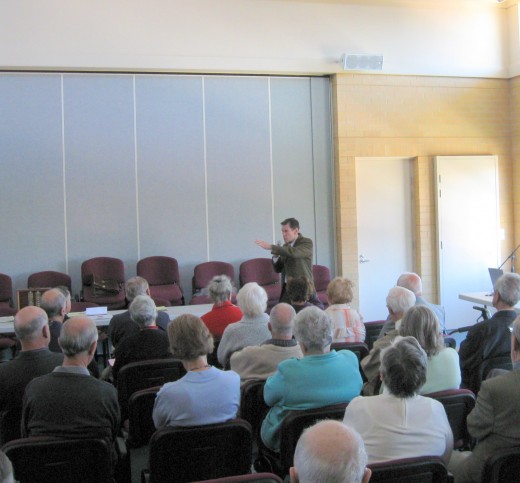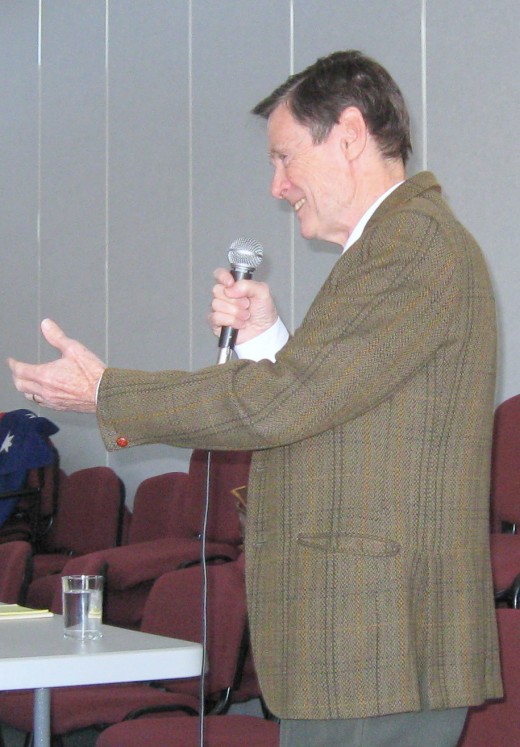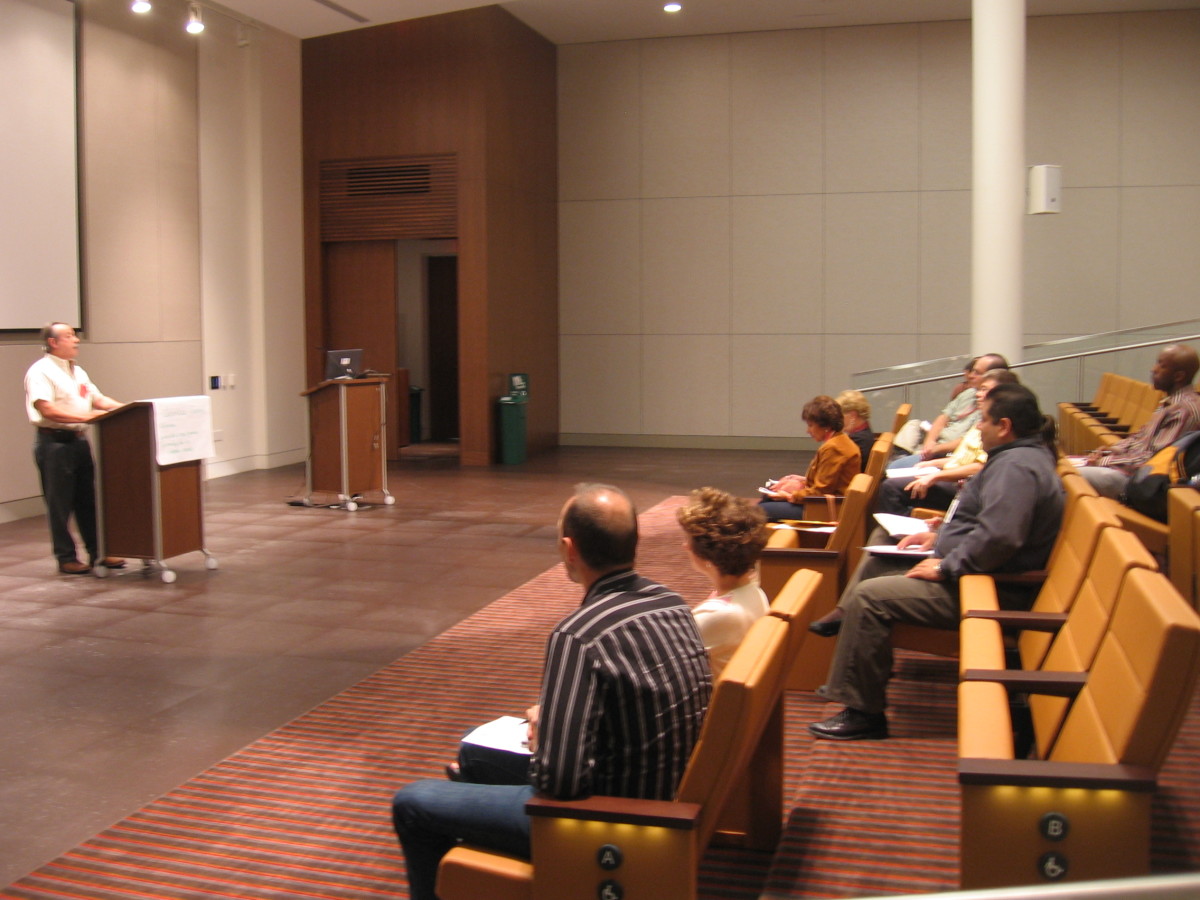Speaking Tips: Public Speaking Skills - Vocal Variety
It took a long time before people started referring to me as one of these, but it was worth it
Public Speaking Fear now well behind him, the writer addressing an audience in 2010

Delivery and Content are of Equal Importance
Welcome to Speaking Tips: Public Speaking Skills - Vocal Variety
Once we get over our public speaking fear, which is simply a matter of acquired confidence, we can concentrate on how we deliver a speech, rather than will we embarras ourselves.
In a speech, what is delivered and how it is delivered are of equal importance. They are two sides of the same coin. The ‘what’ is Content; the ‘how’ is the Method. Delivery and content, always bear both in mind.
Now, we know Content is verbal thought and idea converted into words. The actual words used are Content. The way those words are conveyed to us, along with the appropriate pauses, rises and falls in volume and intensity, fast or slow, smoothly or staccato, make up the actual delivery or method.
The content has to be beneficial to the audience. The delivery has to convince them that this is so.
Want maximum impact?
So how can we deliver our speech for maximum impact?
Answer: by appealing to the audience’s heart; arousing their inner-most emotions concerning our subject. Getting them to feel empathy and, hopefully, agreement- even the desire to act in a way we’d like. For this, after all, is the “Art of Persuasion.”
How do we do this?
By bringing our own heartfelt emotions on our subject (content) so that it impinges on their hearts and is felt deep down. We endeavour to get them to “resonate” to our feelings with their feelings. It can be likened to bringing two tuning forks into close proximity; you are one fork and you are vibrating. You come close to the other fork (the audience) and you set it (them) to vibrating in unison.
Sound complicated?

In speaking, sincerity is our greatest asset
It isn’t. If you’re genuine, sincere, and passionate about your message, the rest will take care of itself.
So what will happen?
VOCAL VARIETY
Well, if you are sincere and passionate, earnest in your desire to persuade (or entertain or inform) you voice will convey this. You will find a natural rhythm as your voice rises and falls; as it speeds up and slows down; as you pause to ponder your next sentence, or to emphasize a particular point.
However, in order for this to become habitual and natural to you, there are steps you probably need take in order to develop this “Vocal Variety,” as it is called. My own method is one recommended by a famous New Zealand speaker and statesman who wrote a book on public speaking. This speaker recommended, “Daily reading out loud.” “Reading out loud as if telling a story.” “Telling a story as if to children.”

Speaking Tips: Public Speaking Skills - Regular reading out loud will develop your vocal variety
Simple in itself: Reading out loud daily for, say, ten minutes, until it becomes a habit.
Reading out what?
Anything, really. But the contents of a telephone directory won’t evoke the images as will, say, a rousing poem, a drama, an adventure story, or a novel. So pick something that both evokes ‘images’ in your mind and ‘emotions’ in your heart. Let the reading “get to you,” so that as you read it your “live it.” In this way, your reading “out loud” will convey all the passion and emotion of that of the author. Feel it as you read it. After some weeks of this it will become your habitual ‘reaction’ as your read. Your voice will find itself automatically using the right intonation, the correct pace, and appropriate pause for emphasis.
Check your progress with a recording
If you want to monitor your progress, I suggest you make a tape recording of a certain piece of prose and then write a date and time on that tape. Do it again in 21 days time. (it takes about 21 days to make a new habit) Play back the first tape and compare it with the second. You’ll be very surprised at the progress you’ve made.
Now to gestures

Don't practice gesturing, be natural unto yourself
GESTURES
Forget about yourself and your public speaking fear and you start to gesture naturally, just as you would in normal, everyday conversation...
Generally speaking, the more emotional you are about a subject, the more ‘heated’ you get, or the more ‘sorrowful’ you get, the more easily, naturally, and readily the gestures will follow. My own view is don’t practice gestures. Let ‘em arise naturally, spontaneously. Practiced gestures look exactly that - practised.
Observe people speaking to family and friends. When we are appealing for understanding or asking for something, the hands come up naturally, palms upwards. When we want someone to “keep the noise down,” for example, the palm faces naturally downwards and we might ‘bounce’ our hand or both hands up and down towards the floor much as if we were bouncing a ball. Or if we are embracing something far, far bigger than ourselves, something magnificent or godly, the arms are thrown upwards and wide, our face to the sky, as our feelings carry us away.
The audience's energy is there for you to use
In speaking, we do become a little ‘larger than life’ if only because the energy of the audience becomes our energy. You might not be able to see this energy, but as sure as ‘God made those little green apples,’ it exists.
A generality: the bigger the audience the bigger and bolder the gestures. The further you are away from the listeners the bigger and bolder the gestures also.
A generality: Gestures are usually done from above the waist. But not always. Some few are done below: For example, “I don’t know.” Open handed, both hands towards the audience can be either below or above the waist line.
Beware of the clenched-fist gesture. Okay to use in fun, but if serious, you could be arousing animosity – which could turn on you.
Beware pointing a finger at the audience. If you feel you need to point, point to the side, or up or down, but don’t point at the audience. Or if you really must, make it very short and sharp, so nobody feels you are pointing at him or her in particular.

Let your gestures arise spontaneously
In summing up the use of gestures: Let them arise spontaneously, from your feelings, not from a calculating mind. If they arise naturally, they’ll enhance your delivery. If they are contrived, they’ll look contrived. So be natural.
So, in a speech, the What is content, and the How is delivery. The what is knowing your subject: the how is knowing how to deliver it. Become a master of both and you’re progress as a speaker will know no bounds.
I hope that your have gained something from Speaking Tips: Public Speaking Skills - Vocal Variety in Speaking Presentation. Let us hope I've managed to allay at least some of that public speaking fear.
I wish you all success.
Tom








